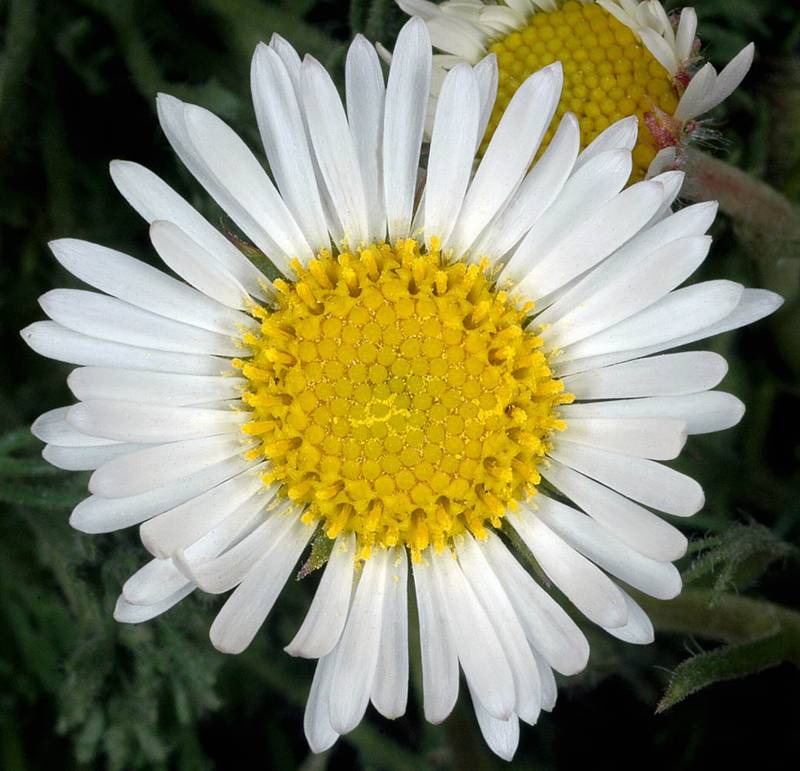|
Eaton's fleabane
|
cutleaf daisy, dwarf mountain fleabane, fernleaf fleabane, trifid mountain fleabane
|
| Perennial from a tap-root, 5-30 cm. tall, the stems decumbent and purplish at the base, with appressed hairs. |
Perennial from a tap-root, 3-25 cm. tall, the herbage densely glandular. |
Basal leaves tufted, narrow, acute, gradually tapering to the petiole; cauline leaves several, conspicuously reduced. |
Basal leaves trifid to ternately dissected; cauline leaves few, linear and entire. |
Heads solitary or up to 7 in an open inflorescence; involucres 5-7 mm. high; rays 20-50, pistillate, white, 5-10 mm. long and 1-3 mm. wide; disk corollas 3.5-5 mm. long, yellow; inner pappus bristles 15-20, outer obscure. |
Heads solitary on long, nearly leafless stems, glandular and hairy; pistillate flowers 20-60, with usually white but occasionally pink or blue rays up to 12 mm. long and 2 mm. wide, or wanting; disk flowers yellow; pappus of 12-20 capillary bristles. |
|
|
|
|
| May-July |
May - August |
| Grasslands, sagebrush, dry slopes, and forest openings at low to middle elevations. |
Sandy riverbanks at low elevations to rocky outcrops at mid- to high elevation in the mountains |
Occurring east of the Cascades crest in central and southeastern Washington; central Washington to California, east to the Rocky Mountains.
|
Widely distributed on both sides of the Cascades crest in Washington; Alaska to California, east to the northern Great Plains, also in northern and eastern Canada.
|
| Native |
Native |
| Not of concern |
Not of concern |
E. acris, E. aliceae, E. annuus, E. aureus, E. basalticus, E. bloomeri, E. caespitosus, E. chrysopsidis, E. compositus, E. corymbosus, E. davisii, E. disparipilus, E. divergens, E. elatus, E. filifolius, E. flettii, E. glacialis, E. howellii, E. inornatus, E. karvinskianus, E. leibergii, E. linearis, E. lonchophyllus, E. nivalis, E. oreganus, E. peregrinus, E. philadelphicus, E. piperianus, E. poliospermus, E. pumilus, E. salishii, E. speciosus, E. strigosus, E. subtrinervis |
E. acris, E. aliceae, E. annuus, E. aureus, E. basalticus, E. bloomeri, E. caespitosus, E. chrysopsidis, E. corymbosus, E. davisii, E. disparipilus, E. divergens, E. eatonii, E. elatus, E. filifolius, E. flettii, E. glacialis, E. howellii, E. inornatus, E. karvinskianus, E. leibergii, E. linearis, E. lonchophyllus, E. nivalis, E. oreganus, E. peregrinus, E. philadelphicus, E. piperianus, E. poliospermus, E. pumilus, E. salishii, E. speciosus, E. strigosus, E. subtrinervis |
|
|
| |
BC,
CA,
OR,
WA
CalFlora,
CalPhotos,
Flora NW,
PNW Herbaria,
Turner Photog.
WildflowerSearch
iNaturalist (observations)
USDA Plants Database



